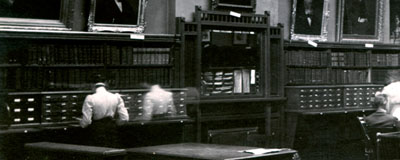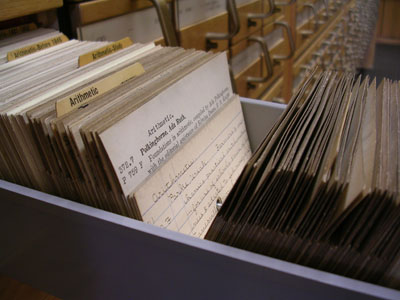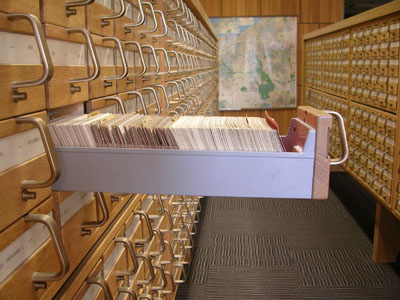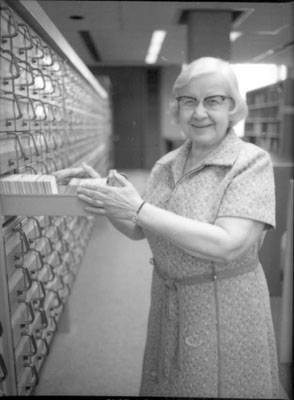Dewey Card Catalog
When recent Oberlin College graduate Azariah Smith Root was asked by the College, in January of 1885, to consider returning to Oberlin to catalog and classify the library collection, he probably didn't know he was taken the first steps on a project that would affect the lives of generations of librarians and students, both at Oberlin College and elsewhere. Root spent the spring of 1885 in careful study of the system advocated by Melvil Dewey in several New England libraries. Dewey Decimal Classification was a recent innovation (1876) and there were as yet no organized library schools to which Root could turn. Nevertheless, in July 1885 Root arrived back in Oberlin and was soon working ten hours a day making a card catalog of both the Union Library Association (a literary society) and the College Library. This was done to coincide with the opening of a brand new building on campus, the Spear Library.
In the fall of 1886, Azariah Smith Root entered the Harvard Law School, but was dearly missed in Oberlin, not least by his sweetheart Anna Metcalf. In January 1887 the Oberlin College faculty adopted a statement of great satisfaction with Root's cataloging work, and on February 3, 1887 (on his 25th birthday) Root was chosen to be library director. So it was that he returned to Oberlin in April 1887 to start his new career. He and Anna were married on April 30th at her home in Elyria.
An article in the Oberlin Weekly News on April 11, 1889 gives us a glimpse of the affects of Root's work on students:
"Librarian Root has rearranged the books in the library - the result of a week's vacation. All the magazines are placed in alphabetical order on the north and east sides of the room, and other changes were made to save time in finding any desired book. With an hour's study at first, upon the arrangement of the material, it is possible now to find immediately the book or article desired in a twinkling of an eye. And with almost 20,000 volumes, not including the U.L.A. library, it is marvelous how little time need be wasted by the student in getting at the gist of his errand to the library."

Image courtesy of the Oberlin College Archives
The library initially used half cards, as advocated by another library pioneer Charles Cutter. This resulted in new equipment purchased for the Spear Library in 1885 (see image). The cards were written out individually. A typewriter was introduced to the staff early in the 20th century but cards continued to be handwritten until the purchase of full-sized preprinted cards from the Library of Congress started in 1908. At that time, new cases for the standard sized catalog cards were purchased and these were interfiled with the old cards. Library staff attempted to replace the older half cards, but thousands survived.

When Root started as OC librarian, the library holdings of his 54 year old institution were still meager and ad hoc; approximately 14,000 volumes and 6000 pamphlets largely representative of the study of Divinity.Yet, by 1891, a report indicated that in the previous five years 10,000 more volumes had been added to the library. That this kind of explosive growth of collections could happen, all while Root complained continuously that he did not have adequate funds for acquisitions, is due to the fact that Root developed the practice of soliciting gifts of books for the library on an unprecedented scale. Oberlin in those days, like now, had more than its share of retired, educated men and women who had personal libraries, and these sooner or later found their way into the College Library. Early in the new century Root also sent letters throughout the country to all living graduates of the College, pleading for gifts of their own writings and books from their libraries. Root also kept an eye out for source material; records of the school board, of village churches, and student organizations that would at a later date be incorporated into the Oberlin College Archives. To cope with a flood of pamphlets, about 1904, it was necessary to place about 40,000 of them in what was called the "long file" arranged by author.
Due to the generosity of philanthropist Andrew Carnegie, a new library building was dedicated in June 1908, the same year Finney Chapel was dedicated. This was an occasion to raise new funds for the library endowment, and because the new library was also to serve as the town's public library, Root was successful, as the President of the Board of Education, in getting the town to pass a one-mill tax levy to support the acquisition of popular materials not commonly associated with academic libraries. The waning ULA library, which by 1908 comprised 14,000 books, was also finally merged with the College Library. This move eliminated duplicate purchasing and brought all the libraries of the college and town under one management.
Astoundingly, in 1910, the Library's annual report ranks OC Library 70th in size in the U.S., and among educational institutions 19th. Among libraries at institutions of strictly college rank it was 2nd in size. It was 4th in size in Ohio behind only the public libraries of Cleveland, Cincinnati, and the State Library of Ohio. In the 1911 annual report Root alleges that:
"During the year, one of our professors who has been preparing a work for publication has again and again spoken to me with delight of unusual books which he had not been able to find in some of the large libraries of the world but which he found in our collection, the gift of some friend in bygone years. It is, of course, difficult always to forecast what any subsequent generation of students and investigators is likely to desire but I have more and more frequent evidence of the wisdom of the policy hitherto pursued by the library in encouraging gifts and in adding material which, at the time, seemed of comparatively little value. I trust that the stream of gifts which for these many years has so greatly enriched our collections may grow broader and richer as the years go on."
To encourage further collections growth, beginning in April 1914, lists of the large number of duplicate books and pamphlets were prepared by Library staff and sent out to other libraries with an offer of exchange for items of interest to this library. The gifts and exchange acquisitions were eclectic, yet had the distinct advantage of allowing the Oberlin College Library the opportunity to acquire materials outside of their normal geographic range of distribution, which were no longer available for purchase, or were too expensive. As a result of this omnivorous collecting history, library staff and patrons remain continually surprised (to this day) at the types of now rare, ephemeral items that turn up in our holdings, all of it faithfully cataloged.
When the decision to finally dispose of the obsolete Dewey catalog was made in 2006 (it had not been keep up to date since the early 1970s), it was decided that we should preserve a piece of this history for posterity as a "Special Collection." The aim of the project was not only to preserve a sample of an early Dewey catalog as a material artifact, but also to provide clues as to which "hidden" collections of 19th and early 20th century material might yet remain to be discovered and preserved.

I spent many days examining each individual drawer of the old card catalog and selecting subject headings to be retained permanently. The list includes subjects of local significance for which we know that our holdings are likely to include both a breadth of material as well as rare items. This project required some familiarity with the history of Oberlin College.
However, I also needed to be open to the discovery of significant "patches" of holdings in subject areas we could not have foreseen. In order to do this I examined the card catalog also from the point of view of the physical state of the cards. As the image above shows, significant congregations of the oldest pre-1908 full cards proved to be easy to spot since, in profile, the cards showed gaps which contained half cards, and were more browned by acid deterioration and a longer period of human handling. These older cards often congregated because the use of the Dewey tables to break down subjects into more specific geographic areas, historical periods, etc. was not applied with much rigor by Root in his early cataloging. Short, simple forms of the subject were used without subdivisions and so frequently survived at the beginning of a subject group. This enabled me to retrieve the early germ of hundreds of subjects totaling approximately 7% of the total. These cards contain a high proportion of early library acquisitions. A list of subjects [XLS download] is available and the cards themselves are still available for patrons to browse on request.

Mary E. Cowles (1910 - 1992)
Image courtesy of the
Oberlin College Archives
For more information about the history of the Oberlin College Library Dewey card catalog refer to the unpublished essays by Mary Cowles. For most of the years from 1942 until her retirement in 1977, Mary was the library's senior cataloger. Those who remember her work remark on Mary's care and vast knowledge of the history of the library. Her experience was invaluable as she helped establish the Special Collections area of the library when it was moved from the Carnegie Building to the present Mudd Learning Center in the 1970s. Ms. Cowles served as a very dedicated volunteer in the library after her retirement until just months before she died.
See also: The Library History Buff. Evolution of the Library Card Catalog
June 5, 2018